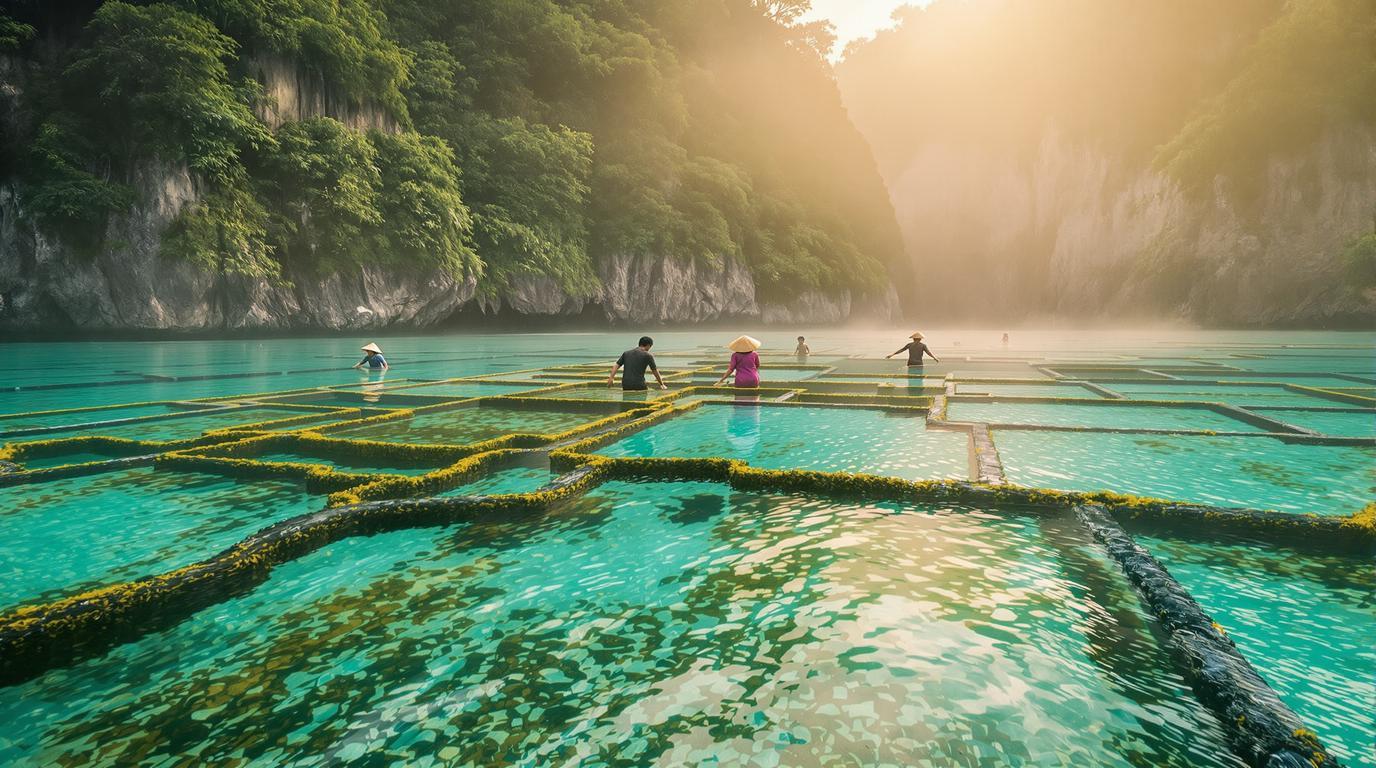The morning light cuts through wisps of sea mist as my boat approaches Nusa Lembongan, revealing a silhouette of mangroves and limestone cliffs that stand in defiance of Bali’s commercialization. This tiny Indonesian island—just 30 minutes from Bali’s shores—seems to exist in a parallel timeline where development paused decades ago, preserving something increasingly rare in Southeast Asia: authenticity without isolation.
Where seaweed farmers and surfers share forgotten shores
Unlike its famous neighbor Bali, Nusa Lembongan wears its history openly. The island’s economy thrived on seaweed farming long before tourism arrived, and this heritage remains visible in the geometric patterns of underwater gardens visible at low tide. These underwater plantations—tended by generations of local families—create a patchwork quilt visible from the island’s limestone bluffs.
“We still harvest seaweed when the tourists leave,” explains Wayan, a weathered farmer who divides his time between the sea and driving visitors on his motorbike. “The ocean gives us two livelihoods now. The old and the new living together.”
What draws travelers here isn’t polished resorts or organized excursions but rather the island’s stubborn refusal to follow mainstream tourism’s playbook. Here, luxury means space and silence rather than amenities.
Three secret corners that guidebooks overlook
The hidden cove behind Mushroom Bay
Most visitors stick to Mushroom Bay’s main beach, but a narrow footpath through limestone rocks reveals a pocket-sized paradise known only to locals. This unnamed cove—accessible only at low tide—offers crystal pools deep enough for swimming but protected from currents. The surrounding rocks create natural shade and privacy, while the resident reef fish perform underwater ballets around your ankles.
The forgotten viewpoint above Devil’s Tear
While tourists cluster at the main Devil’s Tear lookout to watch waves explode through limestone channels, few discover the eagle’s nest perspective hidden 200 yards north. A barely visible trail winds upward through scrubby vegetation to a natural stone platform. From here, the entire southern coastline unfolds—from surfers riding distant breaks to fishing boats returning with the day’s catch, all while remaining blissfully removed from selfie sticks below.
The jungle-wrapped temple at dawn
Pura Puncak Sari sits abandoned most days, its stone guardians watching over mangrove forests from a hidden hilltop. Arrive at sunrise—when the first light illuminates ancient carvings through banyan branches—and you’ll likely have this sacred space entirely to yourself. Local devotees leave small offerings of flowers and fruit, adding splashes of color against weathered stone.
Flavors that define an island’s soul
Forget beachfront restaurants with English menus. The true taste of Lembongan hides behind Jungut Batu village, where Warung Bamboo serves rujak lembongan—a sweet-spicy fruit salad topped with grilled coconut and chili caramel found nowhere else in Indonesia. The dish reflects the island itself: deceptively simple yet layered with unexpected complexity.
The family-run warung operates from their home kitchen, with plastic chairs scattered under a bamboo shelter. No reservations, no set hours—just authentic flavors served whenever the morning market yields the right ingredients.
Navigating island rhythms without tourist crowds
Timing your visit for solitude
May and September bookend the high season, offering perfect weather without July’s crowds. During these shoulder months, accommodations drop by 30% while surf breaks maintain ideal conditions. Avoid weekends when day-trippers arrive from Bali, turning tranquil beaches into extensions of Kuta.
Moving beyond the tourist triangle
Most visitors shuttle between Mushroom Bay, Devil’s Tear, and Dream Beach, leaving the northern and eastern coastlines virtually empty. Rent a scooter ($5 daily) and explore the network of unmarked dirt paths that wind through seaweed farms to reveal pristine beaches without a single footprint.
What remains when tourist crowds fade
As my week on Lembongan ends, I find myself lingering on a clifftop at dusk. Below, seaweed farmers wade through shallows, harvesting their crops as their ancestors did centuries before tourists arrived. Their methodical movements follow the ancient rhythm of tides rather than Instagram schedules—a reminder that the most meaningful destinations aren’t those that change for visitors, but those that invite us to change instead.
